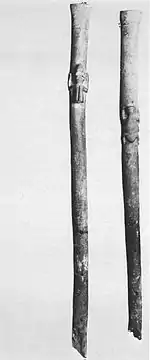Anasazi flute
The Anasazi flute is the name of a prehistoric end-blown flute replicated today from findings at a massive cave in Prayer Rock Valley in Arizona, United States by an archaeological expedition led by Earl H. Morris in 1931.[1] The team excavated 15 caves and the largest among them had 16 dwellings and many artifacts including several wooden flutes, which gave the site its name, the Broken Flute Cave.[2]

The flutes found in the cave were dated between 620 and 670 AD. They were all made of Box elder, have six finger holes and are end-blown.[3] It is similar in many respects to a Hopi flute, which has only five finger holes.
A detailed analysis using radiocarbon dating techniques was published in 2007. The analysis included one item from a burial pit in the Broken Flute Cave. The dating placed the artifact in the range 599–769 AD.[4]
The Anasazi flute has in recent years been reproduced and restored to the catalog of World flutes. While difficult to play in many respects, it has a rich, warm voice that spans a little over one and a half octaves.
See also
References
- Bakkegard, B. M.; Morris, Elizabeth Ann (September 1961). "Seventh Century Flutes from Arizona". Ethnomusicology. 5 (3): 184–186. doi:10.2307/924518.
- Clint Goss (2011). "Anasazi Flutes from the Broken Flute Cave". Flutopedia. Retrieved 2011-03-27.
- Morris, Elizabeth Ann (April 1959). "Basketmaker flutes from the Prayer Rock District, Arizona". American Antiquity. 24 (4): 406–411. doi:10.2307/276601.
- Coltrain, Joan Brenner; Janetski, Joel C.; Carlyle, Shawn W. (2007). "The Stable- and Radio-Isotope Chemistry of Western Basketmaker Burials: Implications for Early Puebloan Diets and Origins". American Antiquity. 72 (2): 301–321. doi:10.2307/40035815.
External links
- ""Pueblo Flutes", Aluaki". Archived from the original on November 18, 2010. Retrieved March 3, 2011.CS1 maint: bot: original URL status unknown (link)
- "The term 'Anasazi'", Aluaki. Accessed: December 07, 2016.
